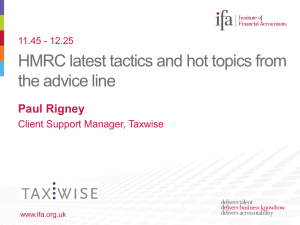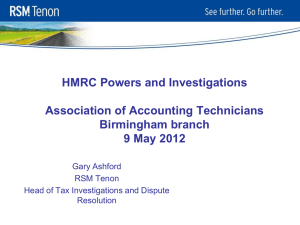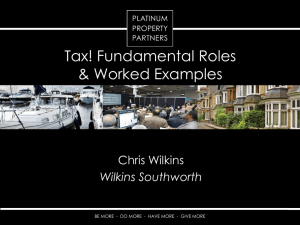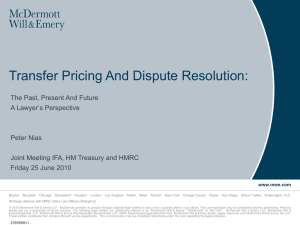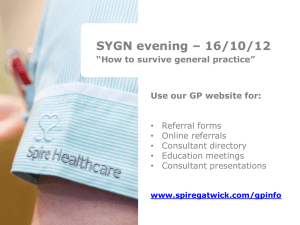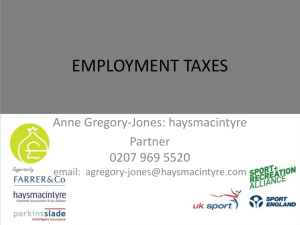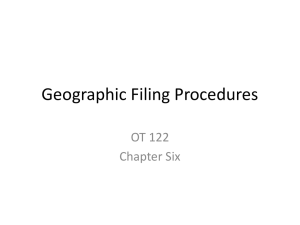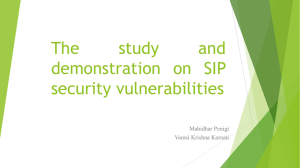The slides used at the discussion forum can be found here.
advertisement
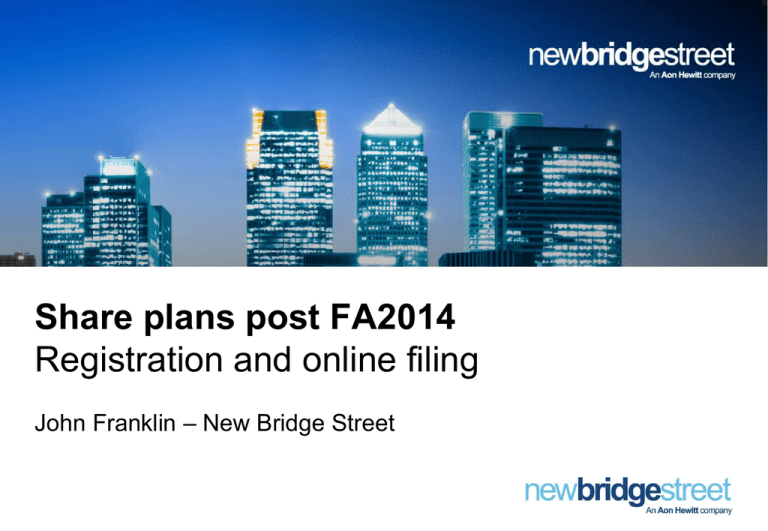
Share plans post FA2014
Registration and online filing
John Franklin – New Bridge Street
0
2014 – a major milestone for UK share plans
1978
Approved
profit
sharing
scheme
1984
Approved
CSOP
2003
2013
Major
overhaul of
unapproved
award
taxation
Overhaul of HMRC approved plans
(including alignment of leaver provisions
and extension of leaver tax relief)
2015
Changes to internationally
mobile employee taxation
2014
2000
1980
Approved Sharesave
Scheme
Approved
SIP
2012
Registration
Disguised
remuneration
anti avoidance
Self certification of tax favoured plans
Online filing
Increased SIP/SAYE limits
Extension of tax relief on change of
control
1
1
The times they are a changin’ at HMRC share plans
Self
certification
Registration
HMRC Share
Schemes Unit
Online filing
2
2
How have we got here?
Online filing for all plans on the cards for some years
HMRC staff progressively reduced (10 to 2)
OTS review of approved and unapproved plans in 2012
2nd stage of OTS recommended reform of tax favoured plans – “HMRC
approval” to be replaced with “self certification”
Made sense to introduce both changes together as a major overhaul of how
HMRC deals with share plans
Registration of plans a necessary first step to implement these changes
3
3
Overview
All plans:
Registration
Online filing
New penalties
Tax favoured plans only:
No more HMRC approval
Self certification
4
4
Registration of plans
All plans
(tax favoured
and non
tax favoured)
Via
HMRC
Online Services
(Payroll ID +
password)
From
6 April 2014
Deadline
6 July 2015
Register
tax favoured
separately
Unique
registration
number
Register
non tax
favoured
separately
or together?
5
5
Registration process
Government Gateway - HMRC Online Services (www.online.hmrc.gov.uk)
PAYE for Employers (User ID and Password)
Employment Related Securities
– Register a scheme or arrangement (Unique ref. no. ≠ )
– View schemes or arrangements
– EMI notifications
– Notify HMRC of cessation of a scheme (provide “date of final event”)
More details:
– www.hmrc.gov.uk/shareschemes/erss-bulletin-15.pdf (Registration
procedure)
– www.hmrc.gov.uk/shareschemes/erss-bulletin-16.pdf (FAQs)
Deadline 6 July 2015 (or 6 July after tax year of first award)
6
6
Registration of tax-favoured and non tax-favoured plans
Individual
registration
Collective
registration
Tax-favoured plans (self
certification required at
the same time)
Non tax-favoured plans
(including “one off
arrangements”)
You can chose scheme name to register under
Get your registration right (name and scheme type cannot be corrected –
only solution is to cease scheme and re-register)
7
7
Who can register
Registration
View PAYE
information
Online ERS filing
Administrator
Assistant
ERS Agent*
(Cannot see submitted
returns)
* 3rd party or internal (some IT teething issues)
8
8
Registration – potential problems of the Government Gateway
Potential problem
Possible solution(s)
PAYE information visible
to person registering
share plans
Register plans under a
separate PAYE reference
from PAYE registration (any
active or live PAYE reference
of a group company)
Possible
downsides
External plan
Register each share plan
Potential late filing
administrators (ERS
under a separate PAYE
penalties for each
agents) able to see plan reference (but is there really a
registration
details plans they do not
problem since ERS agents
administer
cannot see submitted returns
– even their own?)
9
9
Annual returns – move to online filing
Must be filed electronically (unless HMRC agree otherwise)
Applies for year ending 5 April 2015 and later years (so first deadline is 6
July 2015)
First annual return required for earlier of:
– first tax year in which plan is registered (even if not operated!)
– first tax year in which an award is made (if registration is after tax year of
first award)
Once there is an obligation to make a return, one must be made each year
(nil return for any year in which there are no reportable events)…
… until plan terminated (notice given to HMRC that there will be no more
reportable events)
10
10
Online filing - practicalities
It will be possible to upload schedules of data:
– equivalent to attaching spreadsheets to paper returns
– means that information can be provided under a single registration from
different administrators
11
11
Online filing - amending returns
Penalty for errors in a return:
– up to £5,000
– material inaccuracy which is careless or deliberate
– avoided by submitting a corrected return without delay
Amended return required:
– information omitted
– information included that should not have been
– any other error or inaccuracy
More guidance on penalties promised
12
12
Timeline and penalties for late registration/annual returns
October 2014
7 July 2015
Online filing for
2014/15 available
Additional £300
penalty for late
returns
7 January 2016
Additional £300
penalty for late
returns
6 July 2015
7 April 2016
• Deadline for
6 April 2014
• Registration and
self-certification opens
online
• EMI notification
moves online
13
registration/self
certification for 2014/15
awards (£5,000 penalty if
deadline missed)
• Deadline for filing
returns for 2014/15 (£100
penalty if late)
13
7 October 2015
Additional £300
penalty for late
returns
£10 per day
penalty for further
delayed return
Any questions?
14
14
Securing tax approved status for CSOP,
SAYE and SIP as from 6 April 2014
Matthew Ward – New Bridge Street
15
Introduction / content
Introduction
In this talk:
–
–
–
–
–
–
–
–
16
A quick recap on the pre 6 April 2014 approval process
An overview of the new approval process
The self certification deadlines and the impact of missing them
How to self certify
HMRC’s powers to make “enquiries” into plans
Fines for getting it wrong
What to do next for new plans
What to do next for existing plans
16
Pre 6 April 2014
Prior to the launch of a CSOP, SAYE or SIP pre 6 April 2014:
–
–
–
–
Plan rules
Employee guides / communications
Employee application materials
SIP trust deed
All needed pre-clearance /
agreement with HMRC towards
formal confirmation of the plan’s tax
approved status
Post launch of a CSOP, SAYE or SIP pre 6 April 2014:
– Amendments to “key features”
– Adjustment to awards in connection with
a variation of share capital
– Basis for “rolling over” awards
on a takeover
17
17
All needed pre-clearance /
agreement with HMRC to maintain
tax approved status
From 6 April 2014
Prior to the launch of a new CSOP, SAYE or SIP from 6 April 2014:
–
–
–
–
Plan rules
Employee guides / communications
Employee application materials
SIP trust deed
No pre-clearance required from
HMRC
Operation of a CSOP, SAYE or SIP (including existing) from 6 April 2014:
No pre-clearance required from
HMRC in relation to amendments
to key features
– Amendments to “key features”
– Adjustment to awards in connection with
a variation of share capital
– Basis for “rolling over” awards
on a takeover
18
18
May not need pre-clearance /
agreement
Self certification for tax approved status
No more pre-clearance – wholesale change to a process of “self
certification”
Self certification deadlines for new or not yet used CSOPs, SAYE and SIP:
– The plan must be registered (as discussed by John earlier)
– Notice from company to HMRC by no later than the “initial notification
deadline” being 6 July of the tax year following the tax year in which the
plan is first used
– The notice can be made before or after the first award
– Notice (in HMRC prescribed form) to include a declaration by the company
that
• the plan meets the requirements of the relevant Schedule of ITEPA; and
• if notice is being made following the first award, that the plan met such
requirements in relation to such award and since such time
19
19
Self certification for tax approved status
Self certification for existing and previously active CSOPs, SAYE and SIP:
– The plan must be registered (as discussed by John earlier)
– Notice from company to HMRC by no later than the “initial notification”
deadline of 6 July 2015
– Notice (in HMRC prescribed form) to include a declaration by the company
that:
• the plan meets the requirements of the relevant Schedule of ITEPA; and
• has done so since 6 April 2014
20
20
Impact of missing the initial notification deadline
What happens if the “initial notification deadline” is missed?
– Awards in the tax year that triggered the notification requirement will be
non-tax favoured (+ impact on pre 6 April 2014 CSOP grants – next slide)
– Subsequent awards will also be non-tax favoured unless notification is
made by 6 July following the relevant tax year
Example: Grants made in the 2014/15 tax year and in the 2015/16 tax
year. The initial notification deadline is 6 July 2015. Notification is made
late, say August 2015. Only the 2015/16 awards (and subsequent
awards) will be capable of being tax favoured
21
21
Impact of missing the initial notification deadline
Impact of missing the “initial notification deadline” on pre 6 April 2014
awards:
– No impact for SAYE and SIP awards (grandfathered)
– All subsisting CSOP options as at 6 April 2014 lose tax favoured
status!
22
22
Notifying plans to HMRC
How are plans notified to HMRC?
– Completion of a on-line pro-forma “screen” form (which will be available
after the plan has been registered for on-line annual returns)
23
23
Enquiries into plans by HMRC
General powers of enquiry following notification:
– General power for HMRC to make enquiries in relation to a plan (for
example, ask to see the plan documents) within 12 months of 7 July
following the tax year in relation to which a valid registration was made
24
24
Enquiries into plans by HMRC
Overriding powers of enquiry following self certification:
– HMRC may make enquiries in relation to a plan at any time if HMRC has
reasonable grounds for believing the requirements of the relevant
Schedule:
• are not met in relation to the plan; or
• have not been met in relation to the plan
Based on previewed draft HMRC guidance: Where a plan was approved
prior to 6 April 2014, it is accepted that the plan met the relevant legislation at
the time unless new information comes to light!
25
25
Notification of changes to plans / variation of capital
As part of a future year’s Annual Return process, if during the tax year:
– there is any alteration is made to a “key feature”; or
– there has been any variation of share capital, then:
• company required to make a declaration that the alteration or variation
(as relevant) has not caused the requirements of the relevant ITEPA
Schedule not to be met
26
26
Fines for getting it wrong – serious errors!
Fines if HMRC decides a plan is non compliant (HMRC decides, but can be
appealed):
Fine depends on whether the error is:
– serious error; or
– less serious
27
27
Fines for getting it wrong – serious errors!
If HMRC decides a plan is non compliant (HMRC decides, but can be
appealed):
– If a “serious error”:
• the tax advantaged status of the plan may be withdrawn as to future
grants (normally from the time the plan ceased to meet the
requirements); and
• a penalty may be applied of up to twice the amount of tax and NICs
relief already given to participants in the plan up to the date on which the
tax advantaged status is withdrawn and the tax relief that will be given
after that date to those whose status is protected
28
28
Fines for getting it wrong – serious errors!
What is a serious error???
– Not defined, but draft HMRC guidance gives the following example:
• a fundamental or material error in the plan rules than cannot be put right
by either amending or repairing the rules
• for example:
the shares never qualified
the employer was never eligible to establish a qualifying plan
29
29
Fines for getting it wrong – less serious errors.
If HMRC decides the plans are non compliant (HMRC decides, but can be
appealed):
– If a “less serious error*” (still serious):
• if the employer repairs or corrects the error within the 90 days, the plan
retains its tax advantaged status
• the employer may however incur a penalty of up to £5,000
• when calculating the amount of the penalty, HMRC will make judgments
about the nature of errors on a case by case basis taking into account a
range of factors including (but not limited to) the numbers and types of
shareholders involved, the amount of tax involved and the circumstances
that caused the error
* Draft guidance: an error that can be put right by amending or repairing
the plan rules, for example where the error relates to the interaction of
the plan rules
30
30
The meaning of “plan” – not just the plan rules
All turns on a declaration that a plan meets the requirements of the relevant
ITEPA Schedule – But what does “plan” mean for these purposes?
Based on previewed draft HMRC guidance, the following are considered to
be part of the plan:
– the plan rules (and deed where relevant) and the ancillary documents to be
used in operating them
– the provisions in the company's Articles of Association which regulate the
shares and therefore affect the operation of the plan
– the terms of any shareholder agreements to which shares acquired under
the scheme may be subject
– any arrangements made between the plan operators (including
administrators) and the plan participants
– any invitation documents (e.g. SAYE and SIP)
31
31
What next?
For new plans:
– The advisers drafting the plan documents should “sign off” that their
drafting meets the requirements of the relevant ITEPA schedule
– HMRC recommends using its old formal approval checklists!
– Care needed to ensure that the operation of the plan matches the
requirements of the rules and schedules (for example, basis of setting
option prices)
32
32
What next?
For existing plans:
– HMRC signed off the original plan documents (and any amendments) - so
should be ok ?????
– Based on recent Q&A with HMRC they strongly hinted this would be the
case until any change to a key feature
– However:
not yet formally confirmed or law. Watch this space
presumably would only relate to the written documents and not the
operation of the plan
a “health check” of the operation of the plan is recommended
what happens post change of a key feature?
- need to bring the rules fully in line with the new legislation and
current HMRC views (for example: leaver treatment)?
33
33
Any questions?
34
34
Finance Bill 2014
Changes to Tax-Advantaged Plans
Matthew Ward / John Franklin – New Bridge Street
Two years of major change
Recap of changes under the Finance Act 2013
Some proposed measures under the Finance Bill 2014
Practical implications of the changes to your plans
36
36
What changed last year?
Amendment
37
Effective date
Action required?
Single definition of
'retirement'
Retirements on or after 17
July 2013
None – deemed to apply
automatically
Tax-free exercise of
Sharesave and CSOP
options within 6 months of (i)
a change of control of the
employing company; and (ii)
the employee ceasing
employment as a result of a
TUPE transfer
Option exercises on or after
17 July 2013
None – deemed to apply
automatically
Removal of £1,500 limit in
SIP dividend reinvestment
6 April 2013
Deemed to apply
automatically to rules but
check participation terms
Abolition of 7 year
Sharesave contracts
2013
None – deemed to apply
automatically
37
Increase to Sharesave and SIP limits
Sharesave savings limit increased from £250 to £500
SIP partnership share limit increased from £1,500 to £1,800
SIP free shares limit increased from £3,000 to £3,600
Increases effective on 6 April 2014
If plan rules refer to numerical limit, then may require amending
Partnership share agreement and free share agreements may also require
amending
38
38
HMRC formal approvals process abolished
HMRC approval for new plans and changes to ‘key features’ no longer
required (effective 6 April 2014)
BUT still areas where HMRC approval is required – e.g. market value of
shares on an exchange of options
Plan rules may be read as if references to HMRC approval have been
removed but you may wish to update to avoid confusion/errors
39
39
Requirements for CSOP options
CSOP options must meet new conditions at grant
Applies to options granted on or after 6 April 2014
The following information must be stated at the time of grant and notified to
participants as soon as practicable after grant:
- exercise price;
- number and description of shares;
- any restrictions applying to the shares;
- exercise periods applying to the option ('normal' exercise, good
leavers, change of control)
- circumstances in which the option will lapse or be cancelled
- any conditions applying to the option
40
40
Requirements for CSOP options
Amendment of options post-grant now restricted to adjustments following a
variation of share capital or by way of a mechanism stated on grant (e.g.
amendment to performance conditions, time pro-rating)
Mechanism must be applied fairly and reasonably
Plan rules may need to be amended to reflect the new requirements. Option
certificates/communications may also need to be amended
41
41
Changes common to CSOP and Sharesave
Amendment
42
Effective date
Action required?
Exercise of options on death must Options granted on or after 6 April
be permitted "at any time" within
2014
12 months of date of death
None – deemed to apply
automatically
Options may be exercised up to
20 days before, and conditional
upon, a change of control
6 April 2014 (subject to FB14
receiving Royal Assent)
Plan rules must be amended to
take advantage of this provision
Options may be exercised up to
20 days after a change of control
where the shares no longer meet
the requirements of the legislation
6 April 2014 (subject to FB14
receiving Royal Assent)
Plan rules must be amended to
take advantage of this provision
Adjustments following variation of
share capital – total market value
of the shares under option, and
the total exercise price, before
and after the adjustment, must be
"substantially the same"
6 April 2014 (subject to FB14
receiving Royal Assent)
None – deemed to apply
automatically
42
Final thoughts…
Amend your plan rules to incorporate automatic changes to avoid confusion
or errors
Some amendments required to obtain tax relief
Updated rules will assist when you come to self-certifying your plan
43
43
Any questions?
44
44
Matthew Ward | Associate Partner
New Bridge Street | Consulting
10 Devonshire Square | London | EC2M 4YP
t +44(0) 20 7086 9346 | m +44(0) 7810 794 244
matthew.ward@aonhewitt.com
www.nbs-implementation.com
John Franklin | Senior Consultant
New Bridge Street | Consulting
10 Devonshire Square | London | EC2M 4YP
t +44 (0)20 7086 9104 | m +44 (0)777 720 885
john.franklin@aonhewitt.com
www.nbs-implementation.com
45
45

